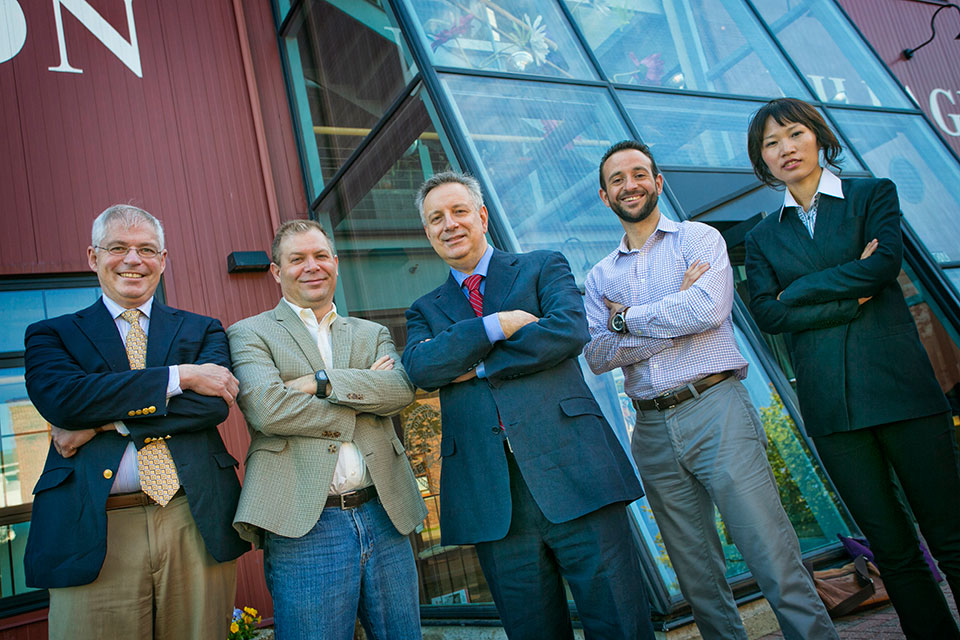 |
| William Worek, Jon Longtin, IACS Affiliate Assistant Professor Sotirios Mamalis and Ya Wang of the Department of Mechanical Engineering stand together for energy technology research with Provost Dennis Assanis (center) |
It took only six months for Stony Brook University to hit an energy research grand slam, earning major federal funding on four projects poised to revolutionize the world’s energy technology.
“These four projects, which together earned nearly $5.7 million in funding, showcase Stony Brook’s dedication to researching and developing technologies that will have a major impact on how we generate and consume energy globally,” said Samuel L. Stanley Jr., MD, President of Stony Brook University.
But how can a state university on Long Island suddenly secure such funding and rise to rank alongside renowned energy research institutions like MIT and Stanford?
The approach is two-fold, said Dennis N. Assanis, Provost, Senior Vice President for Academic Affairs, and Vice President for Brookhaven Affairs — empower newly hired faculty researchers to lead, and make veteran faculty accessible to them, resulting in an innovative team spirit of collaboration.
“Because Stony Brook University is a fairly young institution, anything is possible. We’re fostering a unique culture similar to a start-up,” said Assanis. “Innovation doesn’t usually happen in established, entrenched cultures. Stony Brook’s culture is enabling innovation.”
Such innovation is proven by the recent news that Stony Brook researchers submitted four Advanced Research Projects Agency-Energy (ARPA-E) proposals, and each was accepted. “We cultivated this success at Stony Brook,” said Assanis. “If you’re lucky, it happens once. Four times is not luck anymore.”
ARPA-E, established in 2007 by the U.S. Department of Energy (DOE) and modeled after the successful Defense Advanced Research Projects Agency (DARPA), invests only in the high-risk, high-reward ideas that will create America’s future energy technologies, with the potential to greatly improve the U.S. economy, security and environment.
Stony Brook’s four groundbreaking ideas that got the ARPA-E green light include an “on-demand” targeted air conditioning system that reduces energy costs by 30 percent; a system that condenses water vapor from power plants to reduce or eliminate cooling water use; anovel microemulsion absorption system for supplemental power plant cooling; and a compact, efficient, inexpensive and clean natural gas generator based on a free piston linear alternator, designed to provide electricity and heat in residential homes.
Ya Wang, a newly hired Assistant Professor in the Department of Mechanical Engineering, leads the air conditioning project awarded by the ARPA-E.
“Stony Brook offers a great academic environment,” said Wang. “As a new hire, we inform each other about opportunities and research direction, and encourage each other, which is the best for new, junior faculty.”
Ben Lawler, Assistant Professor in the Department of Mechanical Engineering, works on the ARPA-E awarded project to create a free piston-based generator led by Assistant Professor Sotirios Mamalis.
“The support structure is here to allow us to do what we were brought here to do — next generation research,” said Lawler, who’s only in his first semester at Stony Brook. “The start-up package was generous and gives me the opportunity to do this research, for which I’m most thankful.”
With newly appointed researchers like Wang and Lawler on board, it’s no wonder Stony Brook is shooting four-for-four on the ARPA-E front.
“Our recent faculty hires are infusing new energy into academic departments. We recruit aggressively innovative people who care about translating their science to products that will make an impact,” said Assanis. “In addition to their legacy of excellence, we find that our veteran faculty are rejuvenated when our new hires bring new ideas and excitement to the field.”
Jon Longtin, Professor in the Department of Mechanical Engineering, is one such veteran who joined Stony Brook faculty in 1996. He now leads the ARPA-E awarded project aiming to reduce the need for water in power plants.
“The recent round of ARPA-E awards is a testament to the power of team building and synergy among faculty members,” said Longtin. “I am particularly fortunate to work with this group of colleagues. We represent a diverse, but complementary, group of expertise and skill sets, which makes for a very rewarding and enjoyable experience.”
Now the teams are tasked with using their ARPA-E award funding to develop functional prototypes for independent testing that meets very high performance targets.
At Stony Brook, we’re eagerly awaiting the good news.